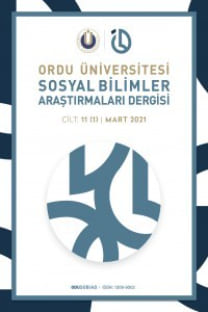Reklam Afişlerinde Göçmenlerin Sosyal Entegrasyonu: Almanya Entegrasyon Vakfı Örneği
halkla ilişkiler, reklam, reklam afişi, sosyal entegrasyon, göstergebilimsel analiz, Almanya, Almanya Entegrasyon Vakfı
Social Integration Of Migrants In Advertising Posters: Example Of German Integration Foundation
Public relations, advertising, advertising poster, social integration, semiotic analysis, Germany, German Integration Foundation,
___
- Barthes, R. (1969). Literatur oder Geschichte. Suhrkamp
- Barthes, R. (1976). S/Z. (Çeviri, J. Hoch, 1. Baskı) Suhrkamp.
- Behrens, K. C. (Ed.) (1975). Begrifflich- systematische Grundlagen der Werbung, Erscheinungsformen der Werbung. Handbuch der Werbung içinde, 2. Basım. Gabler verlag.
- Deutschlanstiftung Integration (DSI) (2023). Über Uns, Mit unseren Aktivitäten wollen wir Vielfalt und Chancengleichheit in Deutschland fördern. 12.01.2023 tarihinde https://www.deutschlandstiftung.net/die-stiftung adresinden erişildi.
- Dubov, A. (2015). Ethical persuasion: The rhetoric of communication in critical care. Journal of Evaluation in Clinical Practice, 21(3) S, 1-7. https://doi:10.1111/jep.12356
- Ehrenstein, C. (2010). Integrationskampagne: “Raus mit der Sprache”. 05.01.2023 tarihinde https://www.welt.de/print/welt_kompakt/print_politik/article10440218/Integrationskampagne-Raus-mit-der-Sprache.html adresinden erişildi.
- Esser, H. (2001). Integration und ethnische Schichtung. Mannheimer Zentrum für Europäische Sozialforschung, No 40, s. 1-77.
- Esser, H. (2006). Sprache und Integration. Die sozialen Bedingungen und Folgen des Spracherwerbs von Migranten. Campus-Verlag.
- Er, M.(2012). İhap Hulusi Görey’in Cumhuriyet dönemi afişlerinin göstergebilimsel açından incelenmesi. Türkbilig, 23, s, 115-132. 05.01.2023 tarihinde https://dergipark.org.tr/en/download/article-file/990224 adresinde erişildi.
- ISSN: 1309-9302
- Yayın Aralığı: Yılda 3 Sayı
- Başlangıç: 2010
- Yayıncı: -
Yazılı Metinlerde Yaradılış ve Lilith
Boşanma Nedenleri ve Boşanma Sonrası Psikososyal Uyum: Trabzon İli Örneği
Video Platformlarında Strateji Oluşturma Modeli Önerisi: YouTube Blogu Tematik İçerik Analizi
Türkiye Üzerinde Yoksullaştıran Büyüme Hipotezinin Analizi: 1970-2020
Duygu ÇELİK, Atilla AYDIN, Burçin ÇAKIR GÜNDOĞDU, Selim AYKAÇ
Etkinlik Turizmi Kapsamında Ordu Vosvos Şenliği Organizasyon Sürecinin Değerlendirilmesi
Taner DALGIN, Emrah KARA, Hüseyin ÇEKEN
Travel Capital: A Qualitative Study on Traveler Earnings
Ramazan ERDEM, Sümeyye ÖZMEN, Ahmet ALKAN, Dilruba İZGÜDEN, Nuray BAĞIRSAKCI
AHP-TOPSIS Yöntemine Dayalı Tedarikçi Seçimi: Ahşap Sektöründe Bir Uygulama
Evlilik Kaygısında Bağlanma Stillerinin Yordayıcılığı
Ahlâkî Değerlerin Ontolojik Kaynağı (Eş’arî ve Mâtürîdî Örneği)
